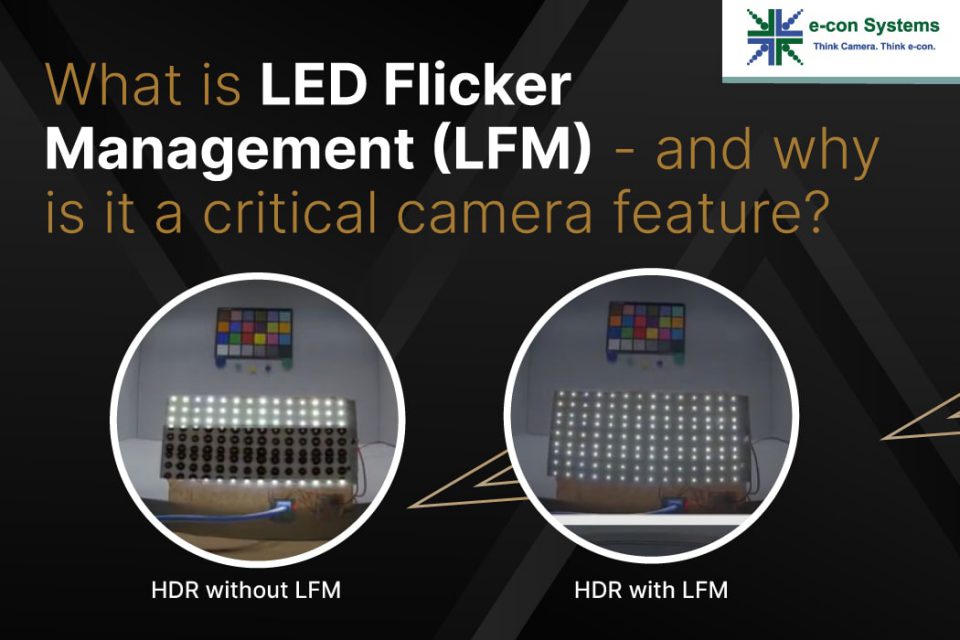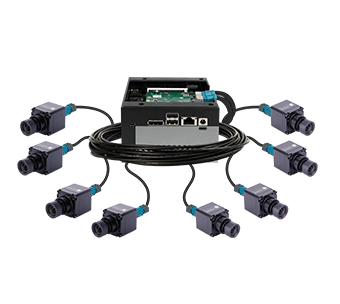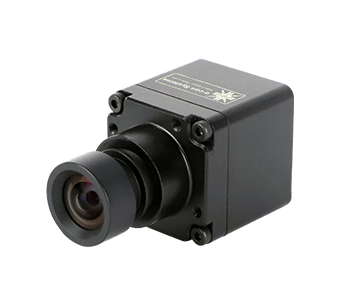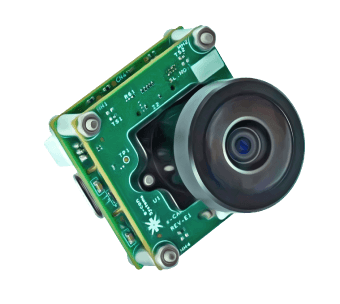Flickers are common in LED (Light-Emitting Diode) light sources such as traffic signals and signboards due to their repetitive ON/OFF cycles – resulting in fluctuations in light intensity, that are not visible to human eyes. When exposed, sensors capable of detecting those flickers may incorrectly perceive the working condition of such LED light sources, resulting in a negative influence on the performance of embedded vision systems. To reduce or eliminate the flickering effect often associated with LED lighting systems, LED Flicker Mitigation (LFM) techniques and technologies are used. Many applications, including AMRs, ADAS, fleet management systems, surround vision systems, agricultural vehicles, etc., require LFM capability to eliminate flickers.
In this blog, you’ll get expert insights on why LED Flicker Mitigation is important for embedded vision systems, the different use cases it enables, and the type of LFM-equipped cameras offered by e-con Systems.
First, What Causes LED Flickering?
Traffic lights, signs, and similar devices utilize LED light sources that alternate between ON and OFF states at a frequency beyond human visual perception. However, capturing these LED emissions accurately with an image sensor poses challenges.
If the sensor’s exposure time is shorter than the ON/OFF timing, the image may be taken during the OFF state, resulting in the failure to capture the LED light emission. Another huge issue is misinterpreting a steady-lit state as a flashing state.
How Does LED Flicker Mitigation Work?
As previously mentioned, LED light sources utilized in traffic lights and signs undergo rapid ON and OFF cycles. To achieve superior image quality while capturing LED-based lights/signs, LED Flicker Mitigation (LFM) technology is crucial.
The LFM approach involves using an exposure time longer than the emission period to ensure the capture of LED light sources. But this can lead to pixel saturation and blowout in certain situations. However, the right sensor helps prevent pixel saturation even when the exposure time exceeds the LED emission period.
One notable example is the Sony® ISX031, an automotive image sensor, which easily addresses this concern. It guarantees that pixel saturation will not occur even when the exposure time extends beyond the LED emission period. As a result, the LED light source can be accurately captured during each cycle, enabling the acquisition of high-quality image signals that are free from any flicker.
Modern technological advancements have led to control algorithms that dynamically adjust the LED current based on feedback from sensors or measurements. These algorithms compensate for variations in LED characteristics, temperature, and aging effects, ensuring consistent and flicker-free illumination.
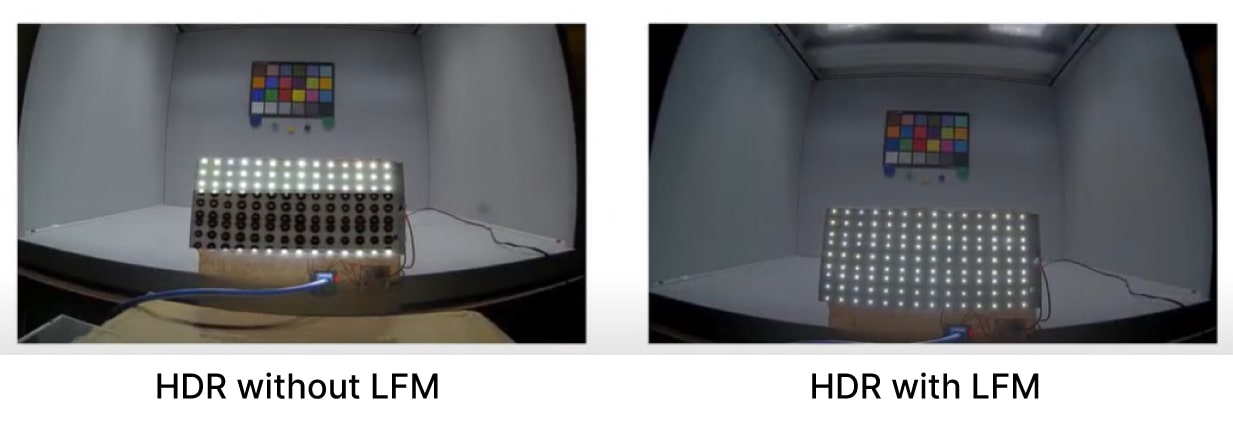
Why LFM is Crucial For Camera-Based Automotive Systems
As you may have seen, pulsed LEDs have become prominent in the headlight/taillight of modern vehicles. The same goes for electronic traffic signals, which are intended to convey information like traffic conditions and speed limits. Hence, it causes undesired LED flickers, which can be a misconception by the system’s working algorithm – leading to potentially life-threatening scenarios.
So, let’s consider an Advanced Driver Assistance System that uses night vision. Suppose its camera’s exposure time and the LED signals from traffic signals (or signboards) are not properly synchronized. In that case, the camera may capture frames when the LED light source is in an unstable state, resulting in visible flickering in the recorded video.
However, with LED Flicker Mitigation technology, the Advanced Driver Assistance System can easily help mitigate the flicker modulations to deliver superior performance while ensuring road/driver safety.
Other Application Use Cases of the LFM feature
- Autonomous Mobile Robots (AMRs)
- Fleet Management Systems
- Surround View Systems
STURDeCAM31 – an IP69K Automotive Grade GMSL2 HDR Camera by e-con Systems
e-con Systems, a pioneer in designing, developing, and manufacturing state-of-the-art OEM cameras since 2003, offers a range of cameras equipped with the LED Flicker Mitigation feature. We are thrilled to announce the launch of the STURDeCAM31 – an IP69K Automotive Grade GMSL2 HDR Camera with LFM for ADAS. Powered by Sony® ISX031, this camera delivers high performance even in challenging lighting conditions. It also comes with split-pixel technology – ensuring exceptional HDR performance without motion blur.
See3CAM_CU31 – 3MP Sony® ISX031 HDR Low light USB Camera
- See3CAM_CU22 – Full HD AR0233 HDR USB Camera with LFM
- STURDeCAM21 – IP67 AR0233 Full HD GMSL2 HDR camera with LFM
- STURDeCAM31 – IP69K Automotive Grade GMSL2 HDR camera with LFM
- STURDeCAM31_CUOAGX – 3MP 120dB HDR NVIDIA® Jetson Orin™ Camera for Autonomous Mobility
- NileCAM21_CUOAGX – HDR GMSL2 Multi-Camera Solution
- NileCAM21_CUXVR – HDR GMSL2 Multi-Camera Solution
- NileCAM21 – Full HD GMSL2 HDR Camera
- e-CAM31_CUOAGX – SONY ISX031 120dB HDR camera for NVIDIA® Jetson AGX Orin™
Please visit our Camera Selector page to see our entire camera portfolio. Also, if you are looking for help integrating LFM-equipped cameras into your embedded vision products, you can reach us at camerasolutions@e-consystems.com.

Prabu is the Chief Technology Officer and Head of Camera Products at e-con Systems, and comes with a rich experience of more than 15 years in the embedded vision space. He brings to the table a deep knowledge in USB cameras, embedded vision cameras, vision algorithms and FPGAs. He has built 50+ camera solutions spanning various domains such as medical, industrial, agriculture, retail, biometrics, and more. He also comes with expertise in device driver development and BSP development. Currently, Prabu’s focus is to build smart camera solutions that power new age AI based applications.




